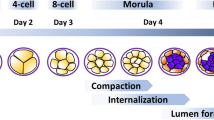Abstract
Mouse blastocyst attaches on the antimesometrial side of the uterus through mural trophoblasts. Later the polar trophoblasts begin proliferation, and rapid multiplication towards the mesometrial side of the uterus occurs resulting in the formation of an excrescence designated as ectoplacental cone. The morphogenesis of ectoplacental cone, viewedin utero, initiates on day 6post-coitum when microvilli of the trophoblast and the uterine epithelial cells are lost and as a result of this opposing membranes appear interlocked with each other. Soon following the invasion by surrounding trophoblasts the necrosis of the epithelial cells starts. Mitochondriae of the epithelial cells, at this stage, are shrunken and lack well defined cristae. Several leucocytes are seen at the site and few electron dense structures appear wedged between the trophoblasts and epithelial cells. At places the cell membrane is studded with the basement membrane of the uterine epithelium giving an impression of a bristle coated membrane. By day 7post-coitum the basement membrane has almost disappeared leaving trophoblast cells to develop close contact with stromal cells. Collagen fibres appeared between the trophoblasts and the stromal cells, many large inclusions of high electron density representing engulfed necrotic epithelial cells are discernible. On day 8post-coitum the ectoplacental cone is fully developed. Four types of trophoblast cells can be identified in it: (i) basal cells lying on the base of the cone, are polyhedral and compactly arranged. They have a large nucleus and well developed nucleoli, (ii) central cells forming the middle area of the cone are of two types; one contained several osmiophilic granules enclosing translucent area (eccentric) and a well developed golgi complex around the nucleus, while the other has many heterophagosomes, vacuoles and residual bodies and (iii) peripheral cells contained several pleomorphic structures resembling secondary lysosomes. Minute dense granules and band of microfibrils on the apical region of these cells are seen. Dense granules probably release lytic proteins at the site and microfibrils help in forming cytoplasmic projections.
Similar content being viewed by others
Abbreviations
- pc:
-
post-coitum
- EPC:
-
ectoplacentl cone
- ICM:
-
inner cell mass
References
Amoroso, E. C. (1958) inMarshall’s Physiol. Reprod., (ed. E. S. Parkes) (London: Longman’s green)2, 258.
Ansell, J. D. (1975) inEarly Development of Mammals (eds M. Balls and A. E. Wild) (Cambridge: Cambridge University Press) p. 133.
Barlow, P. W. and Sherman, M. I. (1972)J. Embryol. Exp. Morphol.,27, 447.
Batten, B. E. and Haar, J. L. (1979)Anat. Rec.,194, 125.
Billington, W. D. (1971)Adv. Reprod. Physiol.,5, 27.
Billington, W. D. (1975) inImmunology of Trophoblast, (eds R. G. Edwards, C. W. S. Howe and M. H. Johnson) (Cambridge: Cambridge University Press) p. 66.
Enders, A. C., Chavez, D. J. and Schlafke, S. (1981) inCellular and Molecular Aspect of Implantation (eds S. R. Glasser and D. W. Bullock) (New York: Plenum Press) p. 365.
Gardner, R. L., Papaioannou, V. E. and Barton, S. C. (1973)J. Embryol. Exp. Morphol.,30, 561.
Kirby, D. R. S. (1971) inMethods in Mammalian Reproduction (ed. J. C. Daniel, Jr.) (San Francisco: W. H. Freeman and Co.) p. 146.
Mehrotra, P. K. (1981)J. Ultrastruc. Res.,76, 312.
Mulnard, J. G. (1970) inOvo Implantation, Human Gonadotrophins and Prolactin (eds P. O. Hubinont, F. Lerox and C. Robyn) (Switzerland: S. Kargar, Basel) p. 9.
Potts, D. M. (1968)J. Anat.,103, 77.
Sandborn, E. B. (1976) Light and Electron Microscopy of Cells and Tissues (New York: Academic Press) p. 162.
Smith, A. F. and Wilson, I. B. (1974)Cell Tissue Res.,152, 525.
Snell, G. D. (1941) inThe Biology of the Laboratory Mouse (ed. G. D. Snell) (New York: Blackistone) p. 1.
Snell, G. D. and Stevens, L. C. (1966) inBiology of Laboratory Mouse (ed. E. L. Green) (New York: Blackistone) p. 205.
Theiler, K. (1972)The House Mouse, Development and Normal Stages from Fertilization to 4Weeks of Age (Berlin: Springer Verlag) p. 4.
Tickley, C., Crawley, A. and Goodman, M. (1978)J. Cell. Sci.,31, 293.
Van Blerkom, J., Manes, C. and Daniel, J. C. Jr. (1973)Dev. Biol.,35, 262.
Author information
Authors and Affiliations
Rights and permissions
About this article
Cite this article
Mehrotra, P.K. Blastocyst attachment and morphogenesis of ectoplacental cone in mouse. J Biosci 6 (Suppl 2), 43–52 (1984). https://doi.org/10.1007/BF02716715
Issue Date:
DOI: https://doi.org/10.1007/BF02716715




